Lasagne is one of those dishes that comfortably falls into the All-Day, Probably Winter Cooking category—but what if it didn’t? Today I’m sharing a recipe that might change your mind about what a lasagne could be (and what it doesn’t have to be—see: all-day, probably winter), a lasagne that’s designed for warm weather and hails from the stunning Italian Riviera: lasagne alla Portofino.
Like many lasagne, lasagne alla Portofino is made with tender sheets of pasta and creamy béchamel. But that’s where the similarities end. You won’t find Emilia-Romagna’s slow-cooked meat ragù (lasagne alla Bolognese); the Marche’s chicken giblets, wine, and white truffles (lasagne all’Ascolana); Campania’s tomatoes, meatballs, and salami (lasagne di Carnevale Napoletana); Sicily’s chocolate-spiked pork ragú (sciabbó); or Friuli-Venezia Giulia’s grated apples, dried fruit, nuts, and poppy seeds (lasagne da Fornel) here. Instead, you’re transported to Liguria, the birthplace of everyone’s favorite summer sauce, pesto alla Genovese (basil pesto).
There are actually two pesto lasagne in Liguria’s culinary canon. One is called lasagne al pesto—the first-ever pasta-pesto pairing—which features the region’s very thin, very square mandilli de saea (silk handkerchiefs) and is unbaked. The other is this one, a more modern iteration dubbed “Portofino-style” perhaps because it was created in that particular coastal fishing village (unconfirmed), but just as likely as a way for traditionalists to differentiate it from the original. I have both versions on my spring/summer cooking list, starting here and ending with those silk handkerchiefs later this summer, when basil plants are burgeoning and ovens are long forgotten.
I’ve written about my love of Ligurian pasta dishes at length (here, here, here), so I’ll cut right to the chase. This lasagne has three main components: pasta (obviously), pesto, and béchamel—four, if you count the finishing touch of Parmigiano-Reggiano. Some iterations also include layers of thinly sliced provola cheese, which I couldn’t resist for its added gooeyness but is totally optional. And because we’re all looking for quicker, lighter fare, I’ve made the whole thing extra-easy by opting for my favorite store-bought pesto from Gotham Greens, for years my preferred source of greenhouse-grown herbs and lettuces; you can simplify this even further with store-bought lasagne sheets (fresh or dried), but since this is a pasta newsletter, I just couldn’t help making my own.
Pesto Lasagne (Lasagne alla Portofino)
Serves 6 to 8
For the pasta
1 batch egg pasta dough or 1 pound (450 grams) store-bought lasagne sheets*
For the béchamel
4 tablespoons (55 grams) unsalted butter
A scant ⅓ cup (55 grams) all-purpose flour
3½ cups (800 ml) whole milk, plus more as needed
Kosher salt
Whole nutmeg
For assembly & serving
2 to 3 (6½-ounce) packages Gotham Greens classic pesto or 12 to 16 ounces (340 to 450 grams) homemade basil pesto, at room temperature
18 to 24 extra-thin slices (not smoked) provolone or low-moisture mozzarella (optional)**
1½ ounces (45 grams) finely grated Parmigiano-Reggiano
Toasted pine nuts, for serving (optional)
Fresh basil leaves, for serving (optional)
*A batch of my standard egg pasta dough will yield enough pasta sheets for about 5 layers; a 1-pound box of store-bought noodles will yield about 4 layers (so, if you want a slightly taller lasagne, grab an extra/bigger box). Avoid no-boil noodles if you can.
**For a 9x13 baking dish, you’ll need about 6 slices per layer, excluding the top. If you can’t find extra-thin slices, opt for regular thin slices and alternate layers (excluding the top) so the cheese doesn’t overpower the dish.
For the pasta
Make the dough:
Make the dough by hand or in a food processor according to the directions in this post. Let the dough rest, tightly covered, at room temperature for at least 30 minutes and up to 2 hours.
Roll the pasta sheets:
Cut off a quarter of the dough and re-wrap the rest. On your work surface, flatten the section of dough with your palm into an oval-shaped pancake that’s about ¼-inch thick. Press the dough between your fingers to thin it out as needed.
Set your pasta machine to its widest setting. Position one tapered end of the oval in the center and roll it through once—you should be left with a longer, thinner oval.
Position the dough lengthwise on your work surface. Then fold the two tapered ends into the center like an envelope so the length is the same or similar to the slot of the pasta roller (about 6 inches; it doesn’t matter if the tapered ends overlap or if there’s space between them). Flatten the dough again with your palm/fingers so it’ll go through the machine easily.
Line up the bottom edge of the pasta envelope with the edge of the machine (the folded ends should run horizontally). Roll the dough through the machine on the same (widest) setting a second time—you should be left with a rectangular-ish piece of dough (it’s okay if the ends aren’t perfect!).
Continue rolling the dough through the machine one time on each progressive setting until you have a thin sheet (on a Marcato Atlas 150, I roll the dough to setting 6, and then a second time on setting 6; on a KitchenAid machine, I roll the dough similarly or, for slightly more delicate sheets, to setting 7). If the dough feels sticky or tacky as you roll, dust both sides with some 00 or all-purpose flour.
Cut the pasta:
Trim away any uneven edges and cut the pasta sheet into roughly 6-inch squares (a quarter of the dough should yield 4 squares). Arrange the squares on your wooden work surface if you have the space, or in a single layer on a parchment-lined sheet pan. Repeat with the remaining dough, layering the squares between sheets of parchment if needed to prevent sticking.
As you go, ball up the dough scraps and re-wrap them to rehydrate, then roll those again at the very end so you have some extra squares to work with if you need them.
Blanch the pasta:
Bring a large pot of water to a boil and season it generously with salt. Fill a large bowl with ice water. Line a sheet pan with a clean dishcloth/tea towel and keep a few more on hand.
Drop a few pasta squares into the boiling water and gently stir. Cook for 30 seconds, then use a spider sieve to transfer the pasta to the ice water. When cool, shake off any excess water and arrange the squares in a single layer on the dishcloth/tea towel and pat dry. Repeat with the remaining squares, layering them between clean dishcloths.
If using store-bought lasagne sheets, prepare them according to the package directions.
For the béchamel
In a medium saucepan, melt the butter over medium heat. Add the flour and cook, using a whisk to mix constantly, until it smells nutty and the mixture starts to loosen and bubble, 2 to 3 minutes.
While continuing to whisk, gradually add the milk, either in a slow, steady stream or a splash at a time. (It’ll start out very thick and then thin out significantly once all of the milk is added.)
Increase the heat to medium-high and, still whisking, cook until the sauce thickens to the consistency of a creamy soup and coats the back of a spoon, about 5 to 7 minutes more (it’ll continue to thicken as it cools). Turn off the heat. Season to taste with salt and freshly grated nutmeg.
To hold for more than a few minutes, cover the surface of the sauce with a layer of plastic wrap to prevent a skin from forming (if this happens, don’t worry—just whisk it occasionally; you won’t notice any lumps once it’s baked). Whisk again before use and, once cool, if it seems too thick, loosen it with a splash of milk.
Storage note: The béchamel can be stored in an airtight container in the refrigerator for up to 3 days or the freezer for up to 1 month. Reheat over low heat and loosen with more milk or warm water as needed.
For assembly & serving (see video above!)
Heat the oven to 375°F.
Ladle some béchamel into the dish, spreading it out in a thin layer with the bottom of the ladle or a spoon.
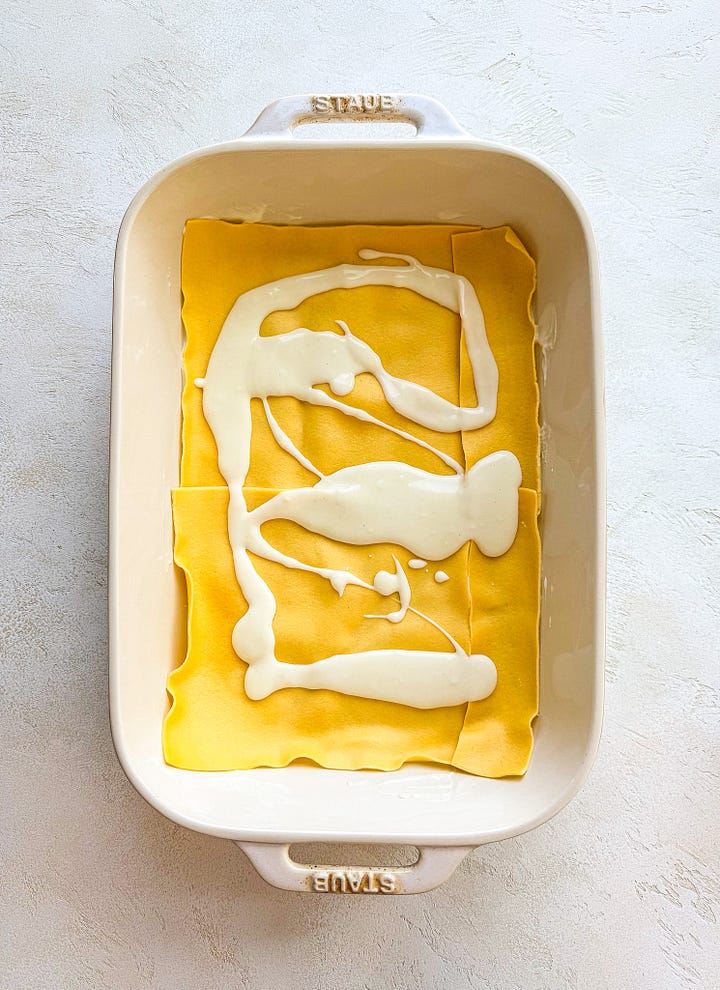
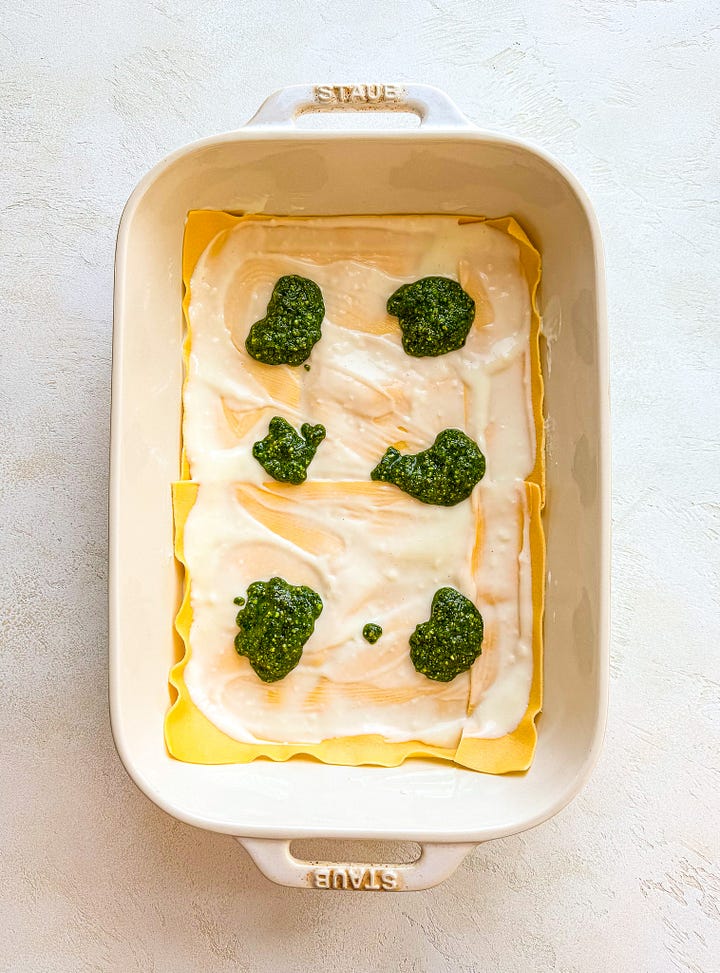
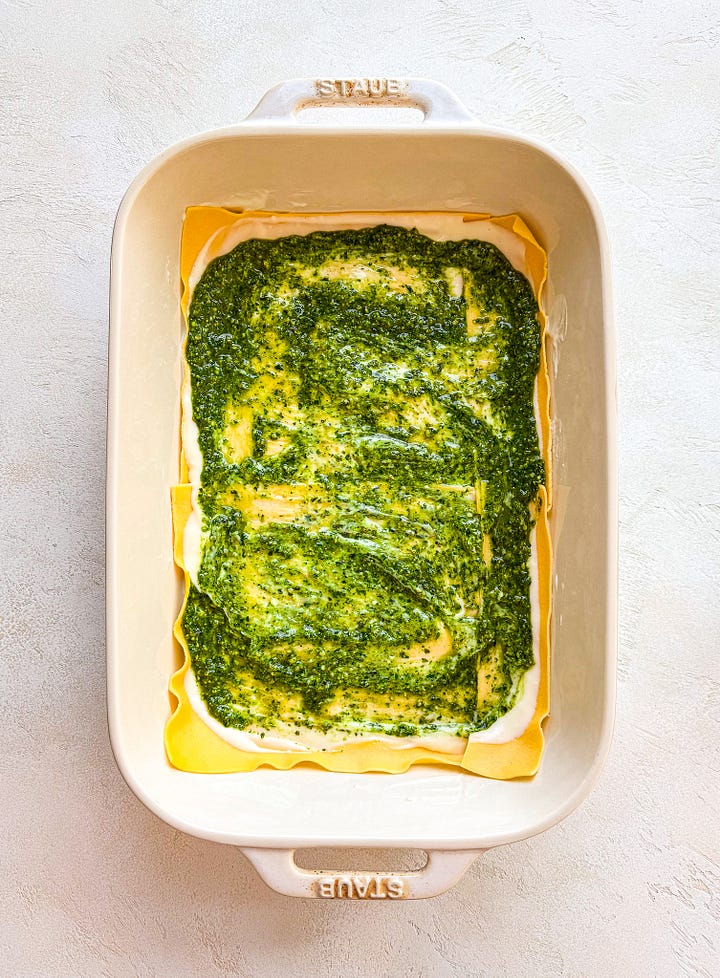
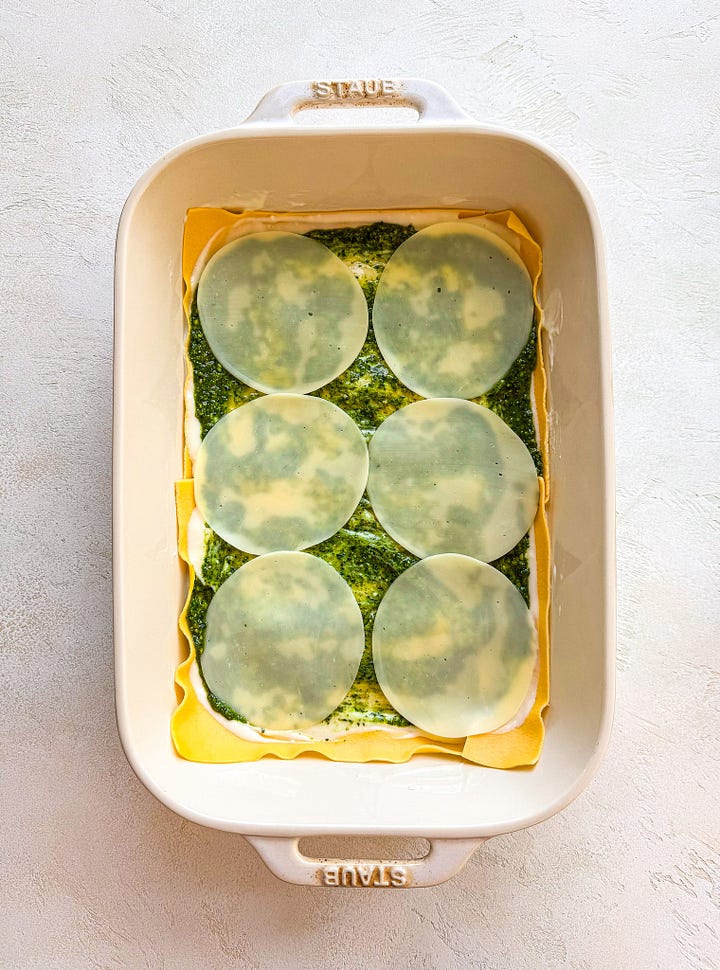
Layer some pasta on top to fill the dish, cutting and overlapping the pieces as needed (for crispy edges, let some of the pasta go up the sides). Ladle another layer of béchamel on top and spread it around, then spoon over some of the pesto and spread that too across the pasta using the back of the spoon or a spatula—don’t worry if there are gaps. Layer a few slices of provolone on top.
Repeat (pasta, béchamel, pesto, provolone) ending with pasta, then pesto, followed by béchamel, and finishing with the Parmigiano-Reggiano.
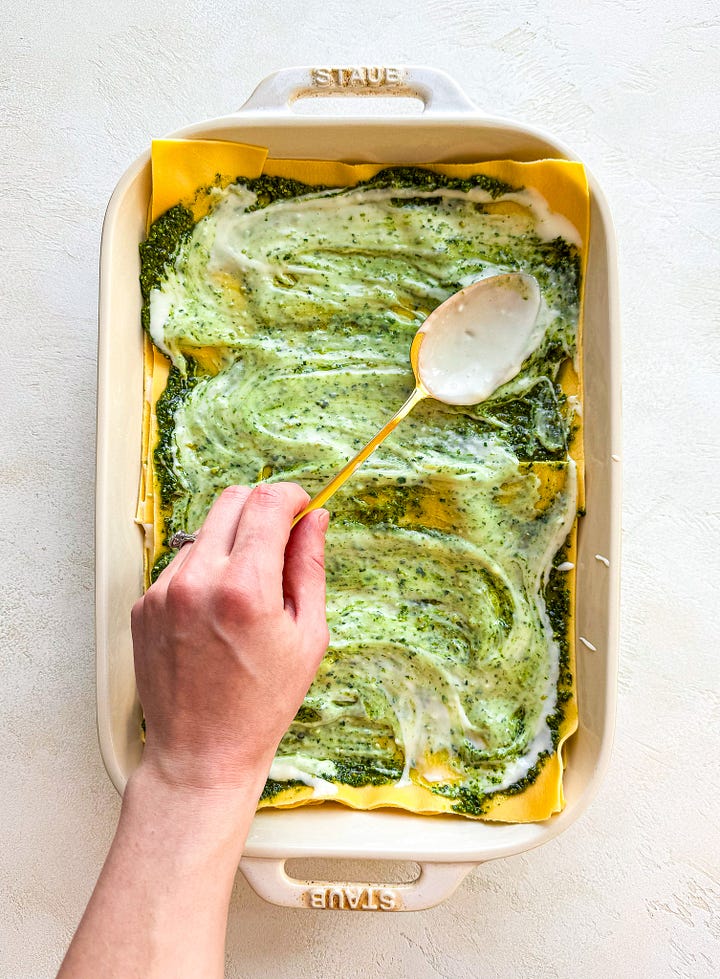
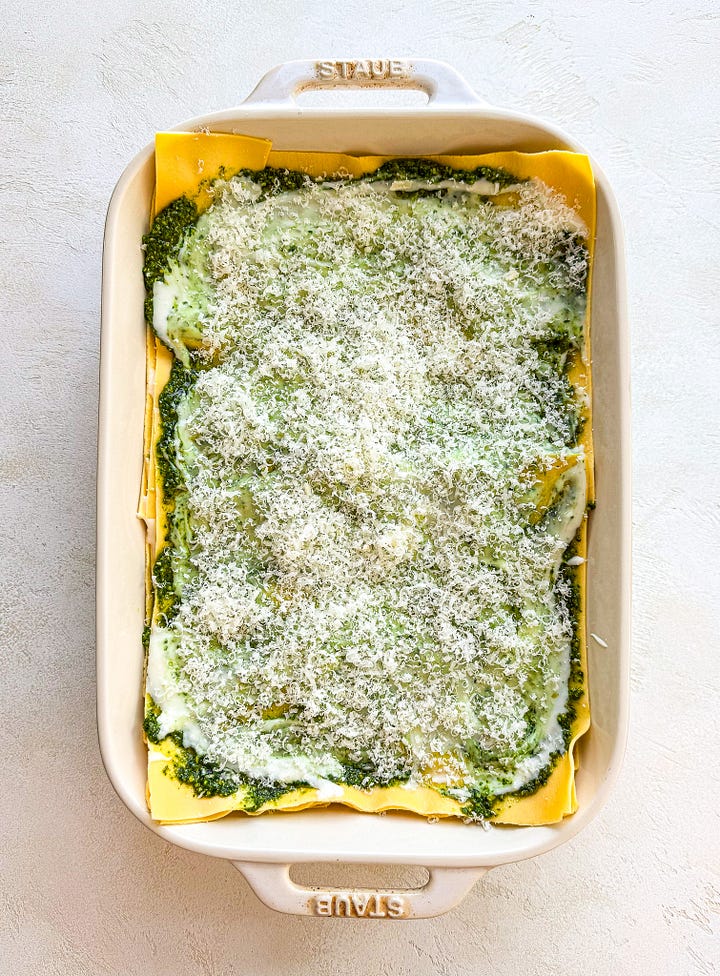
Cover the baking dish with foil and bake on the middle rack for 30 minutes. Uncover and bake until bubbling and golden around the edges, 15 to 20 minutes more. Broil the top for a few minutes for extra color (optional).
Remove from the oven and let stand for at least 15 minutes. Sprinkle with toasted pine nuts and fresh basil leaves before serving, if you’d like.
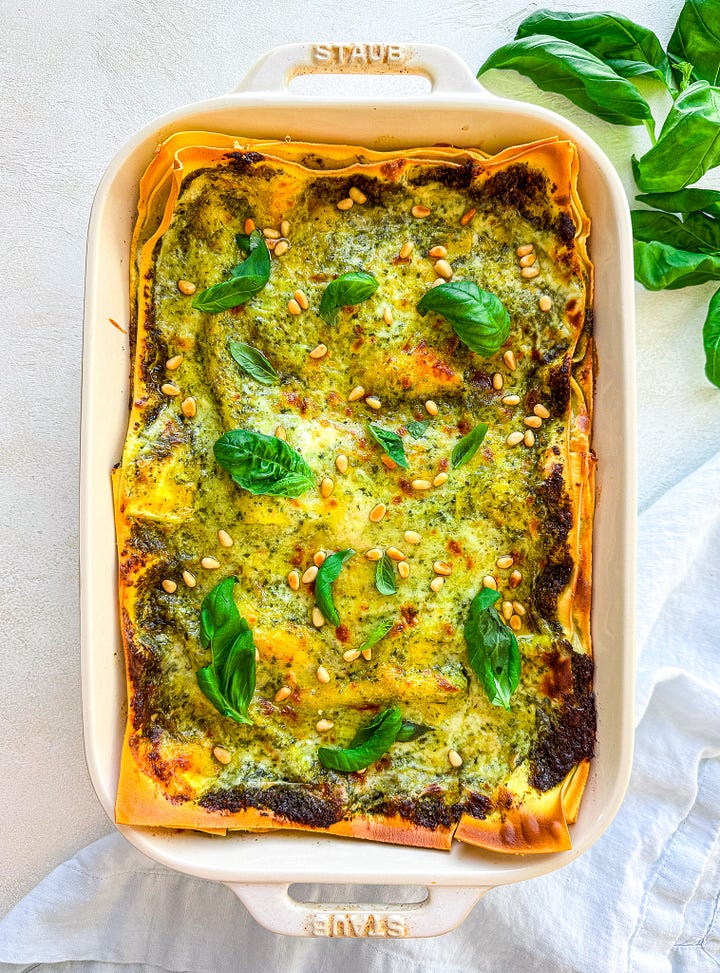
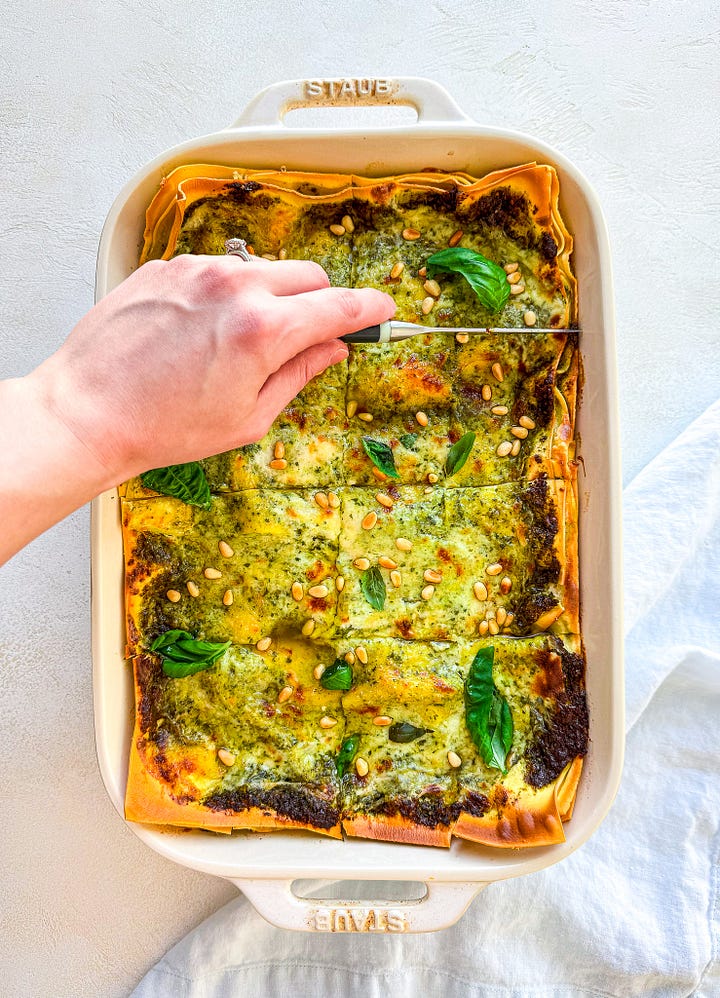

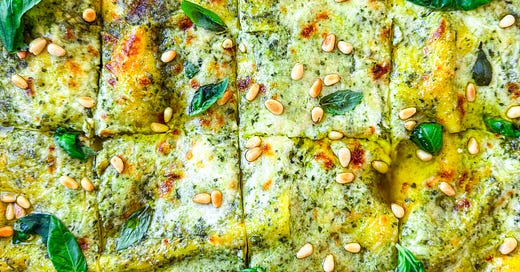


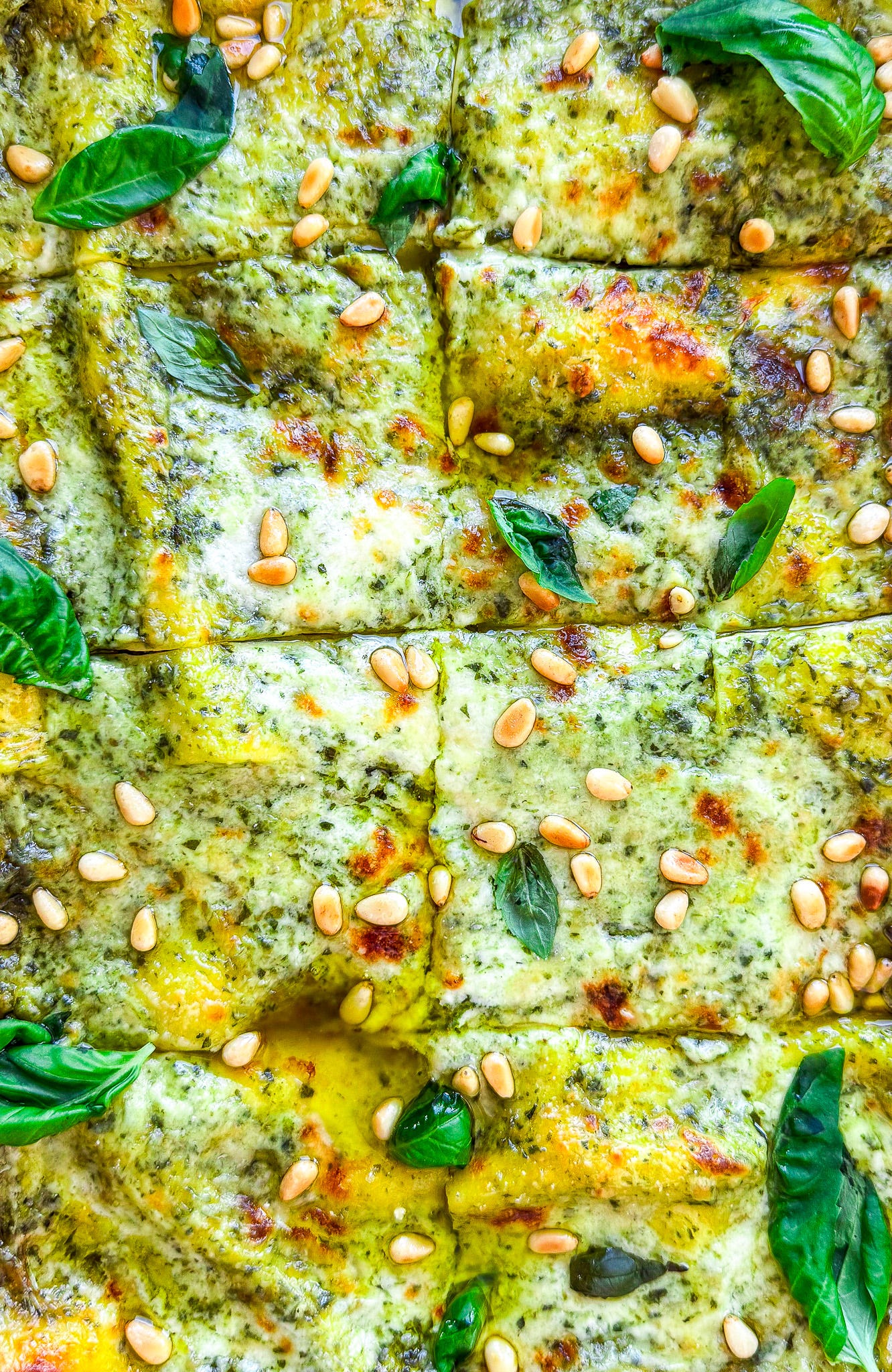
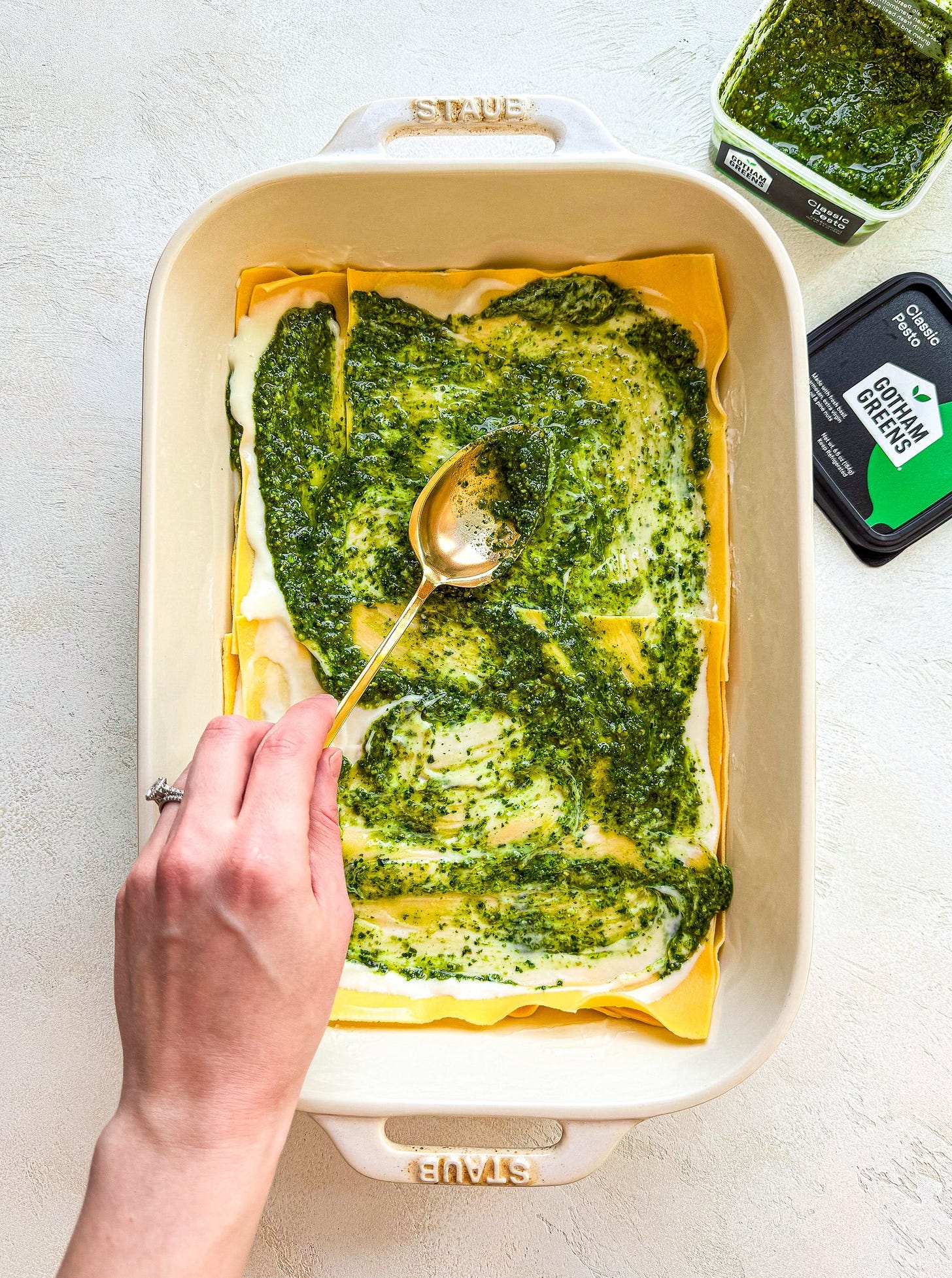
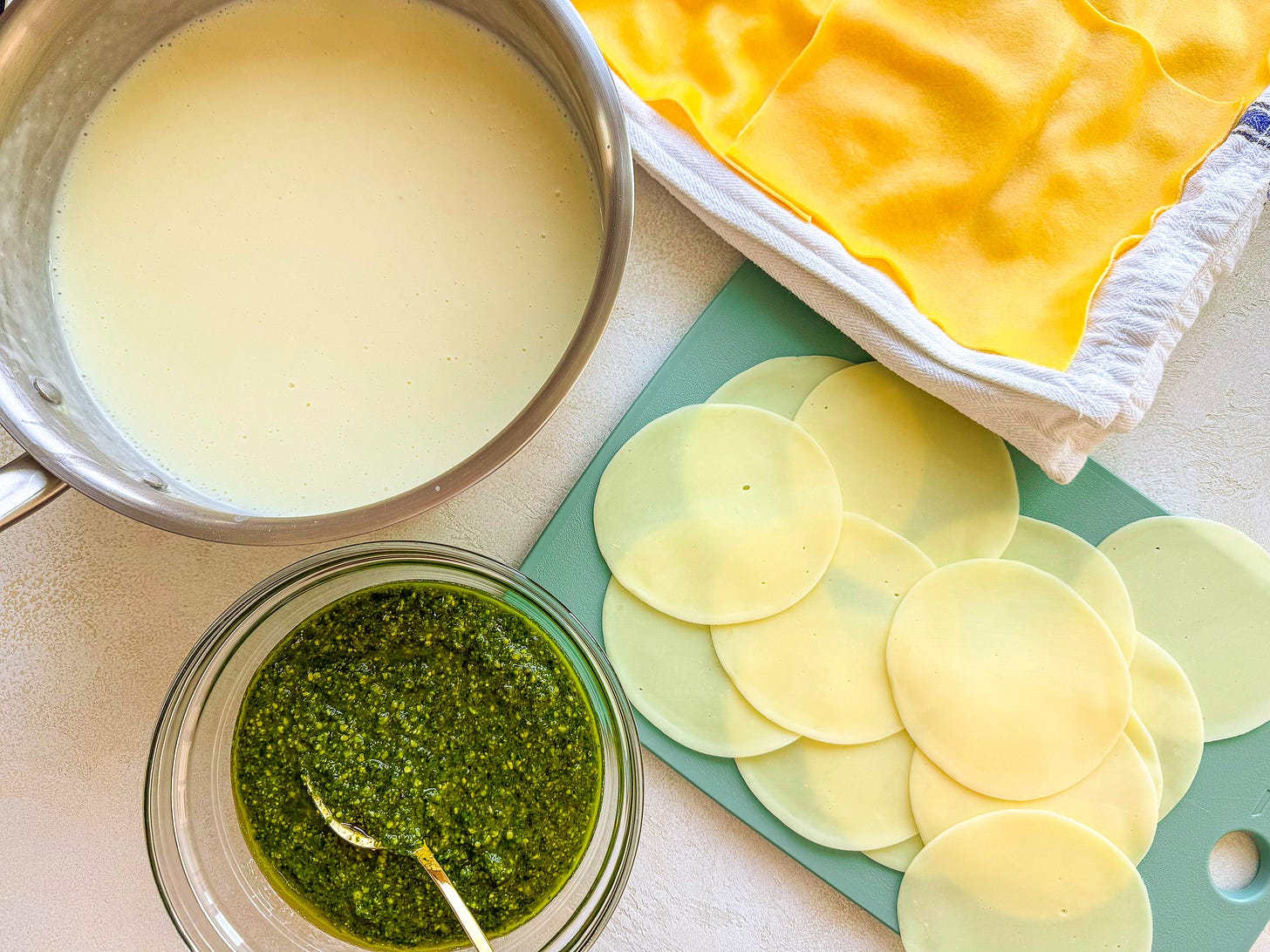
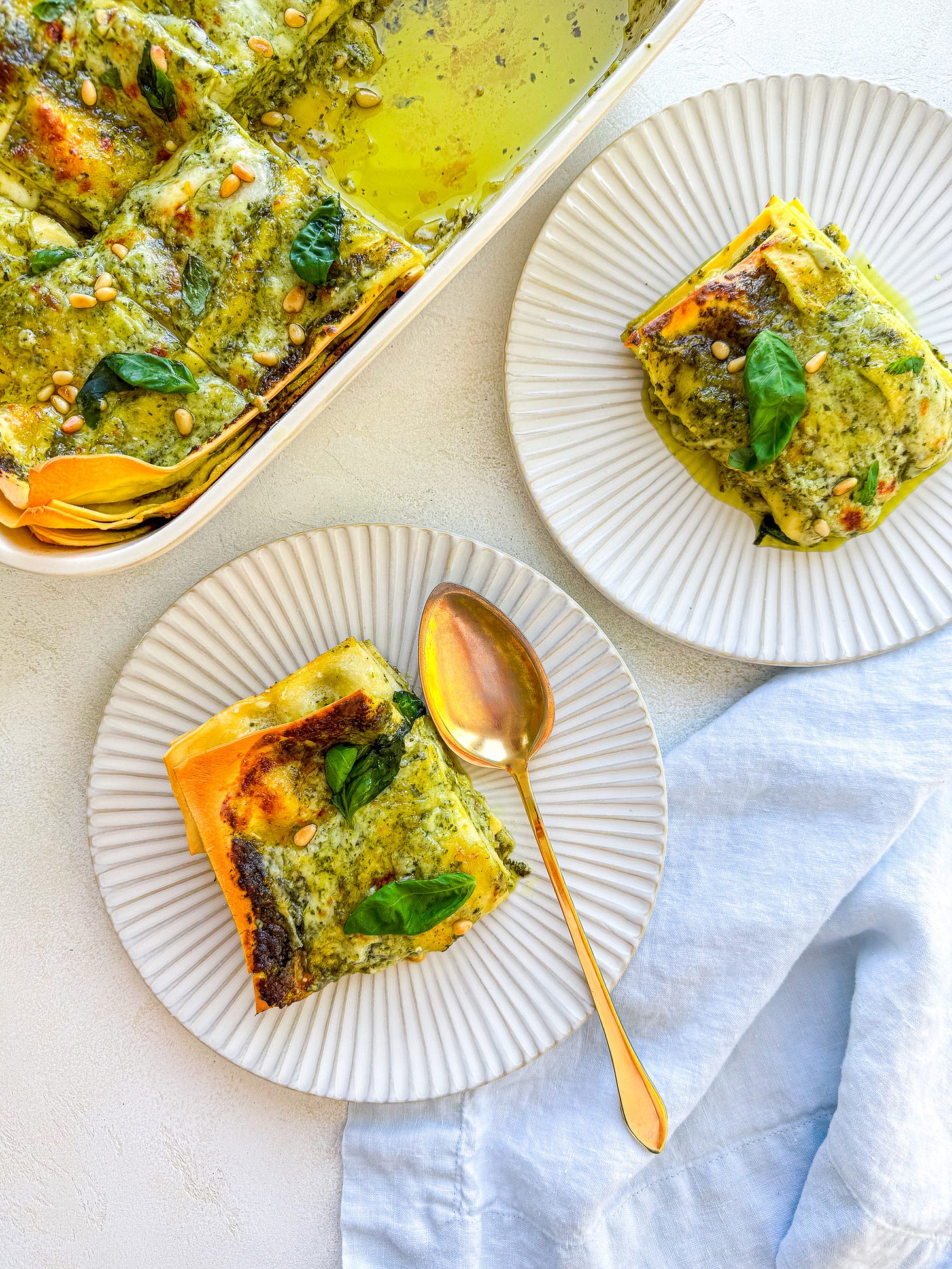

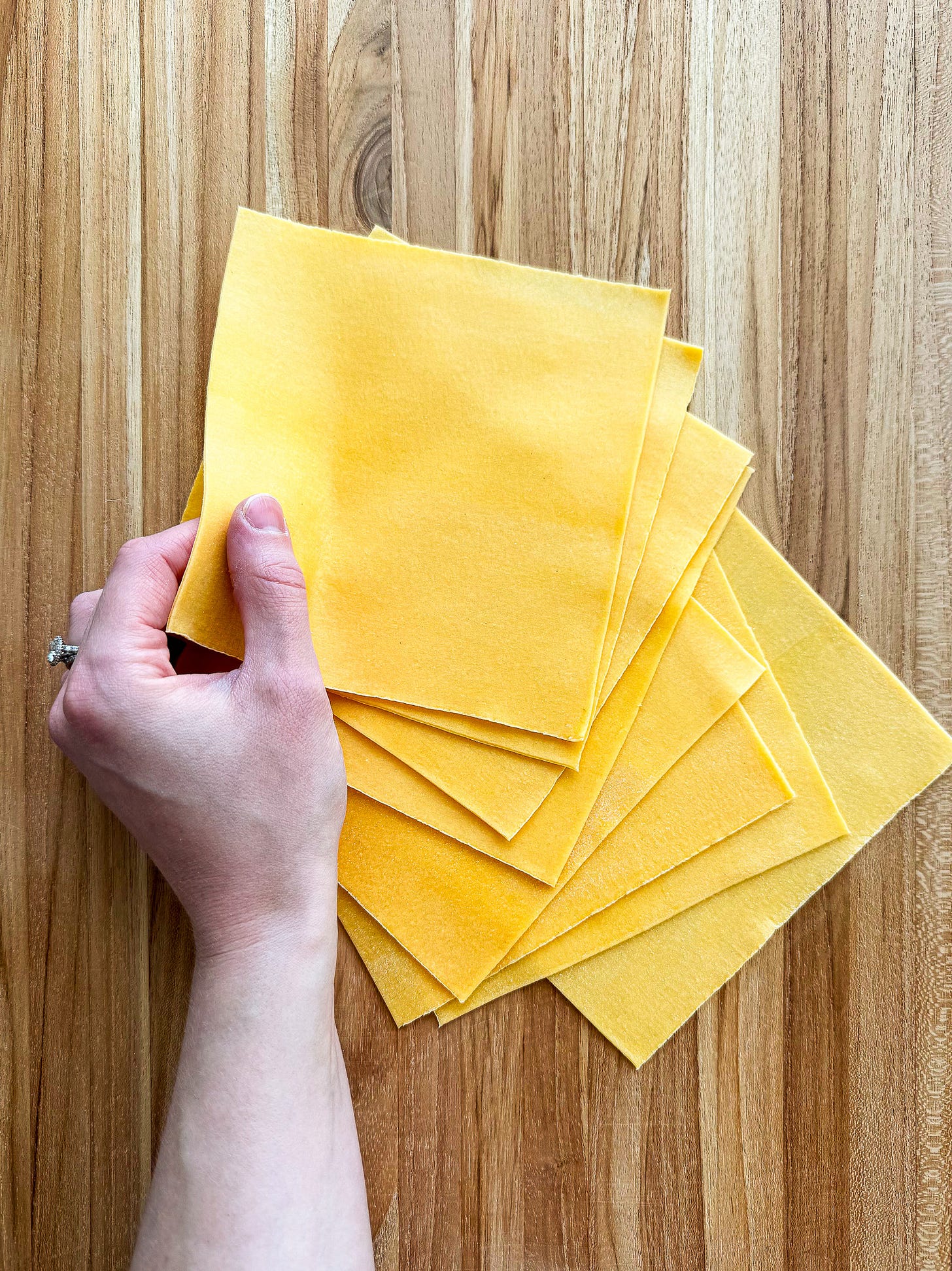

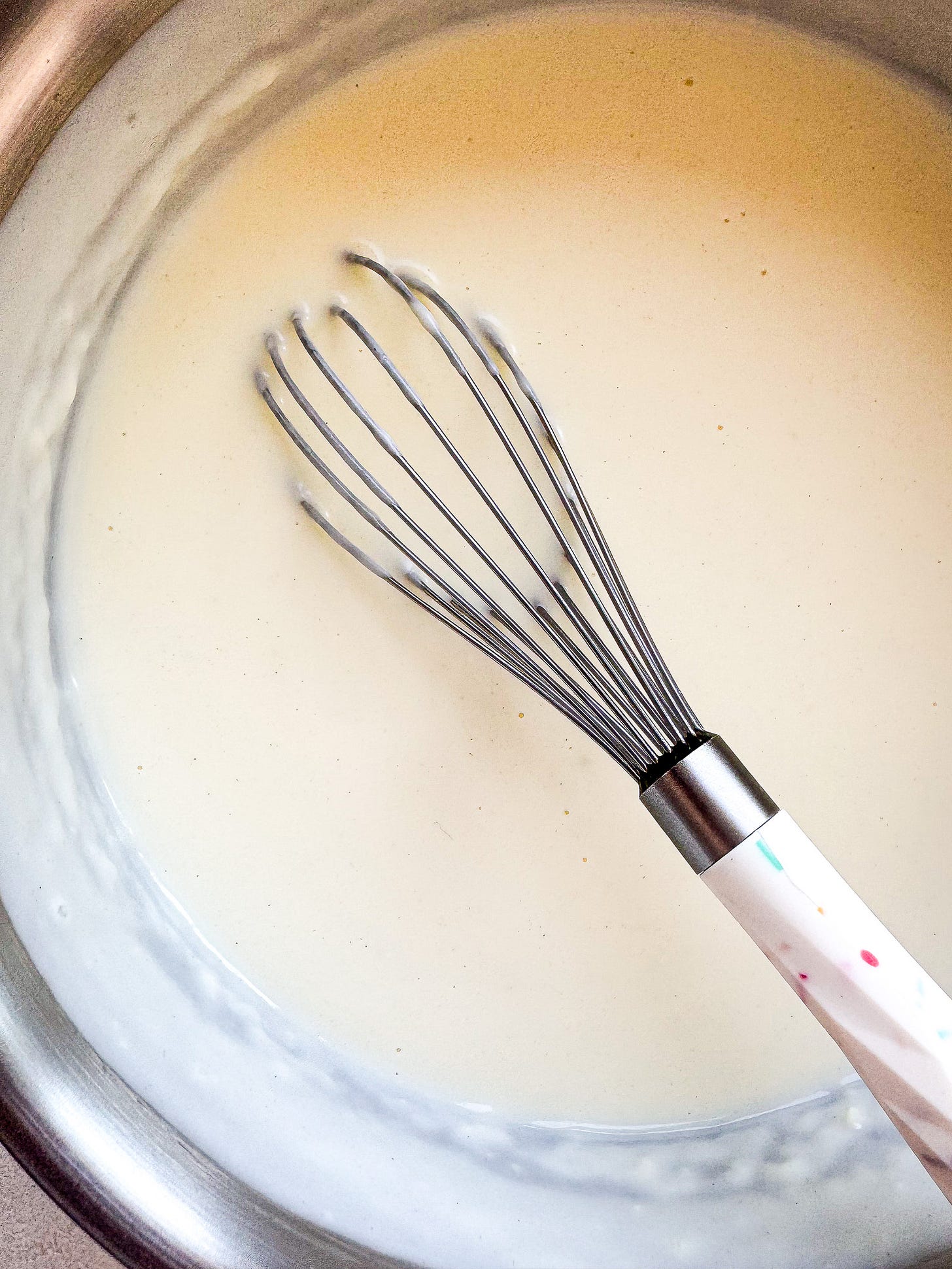

Just wow! Will make.
Made it last night! Delicious!